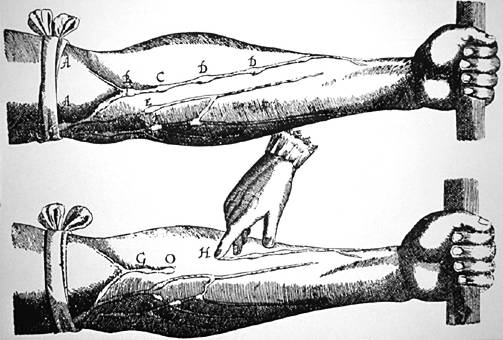William Harvey's
On the Motion of the Heart and Blood in Animals.
To illustrate that blood is pumped out from the heart in arteries
and back to it in veins, Harvey says that different types of ligatures,
or tourniquets, applied to the limbs produce different results. Tight
ligatures prevent blood from flowing to the limb because they impede
flow through the arteries, and no pulse can be felt distal to the ligature.
Medium to loose ligatures, on the other hand, cause the extremity to
swell and deepen in color. This is due to the fact that, while the blood
is more forcefully pumped through the arteries to the extremity, and
thus makes it past the ligature, the blood in the veins is moving much
less forcefully; the pulse of the veins is not sufficient to pump the
blood past the ligature, which causes blood to accumulate and the extremity
to swell.

The fact that veins have one-way valves, which arteries do not, can
be observed by tying a medium to loose ligature around the upper part
of the arm, above the elbow, and clenching the fist repetitively to
cause blood to be pumped to the hand. The veins will swell with the
blood that is blocked by the ligature from returning to the heart, and
small bulges will appear at fairly regular intervals along the vein;
these bulges are the valves. If one presses a finger just proximal to
a valve and then uses another finger to push the blood out of that section
of the vein into the section just past the next valve, the blocked-off
valve will remain collapsed until the first finger is removed. This
illustrates that the veins have valves, that the valves are one-way
only, and that the veins are passively filled due pressure gradients
in the circulatory system.
Harvey furthers his point that blood circulates by saying that the entire
body suffers from a snake bite on the foot, which would be impossible
unless there were some means of conveyance of blood from the foot to
the rest of the body. This is also true of some drugs and poisons applied
to the skin, which still affect the entire body.
Harvey sums up his findings and ideas to this point:
Since all things, both argument and ocular demonstration,
show that the blood passes through the lungs, and heart by the force
of the ventricles, and is sent for distribution to all parts of the
body, where it makes its way into the veins and porosities of the flesh,
and then flows by the veins from the circumference on every side to
the centre, from the lesser to the greater veins, and is by them finally
discharged into the vena cava and right auricle of the heart, and this
in such a quantity or in such a flux and reflux thither by the arteries,
hither by the veins, as cannot possibly be supplied by the ingesta,
and is much greater than can be required for mere purposes of nutrition;
it is absolutely necessary to conclude that the blood in the animal
body is impelled in a circle, and is in a state of ceaseless motion;
that this is the act or function which the heart performs by means of
its pulse; and that it is the sole and only end of the motion and contraction
of the heart.